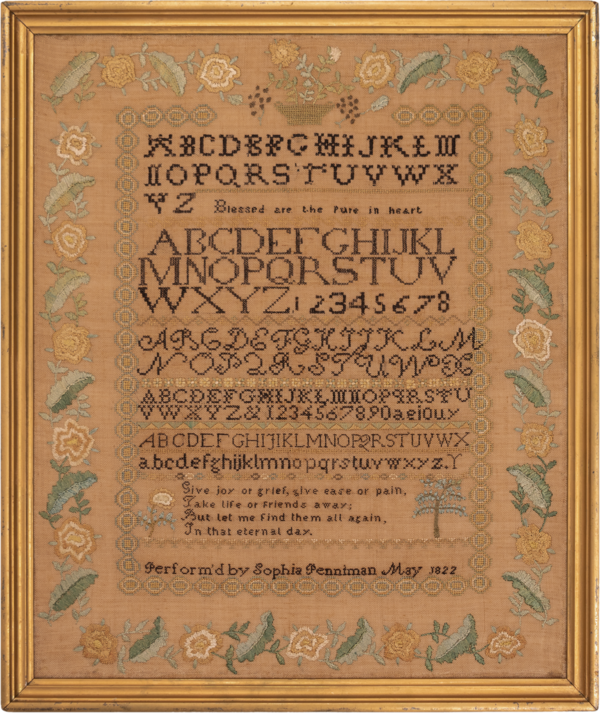Sophia Penniman
New Bedford, Bristol County,
Massachusetts, 1822

The coastal Massachusetts town of New Bedford is nestled into Buzzard’s Bay, 50 miles south of Boston. It was one of the most important whaling communities of the early 19th century. The highly lucrative whaling industry allowed New Bedford, along with its neighbor Nantucket, to enjoy considerable success. An early geographical gazetteer of New England indicated that New Bedford was “laid out into beautiful streets, which contain many costly and superb dwelling,” and further indicated that “the inhabitants of this town have manifested a commendable liberality in providing the means of education.”
The town had an active Quaker community and a school that taught needlework and samplermaking to female students, as evidenced by an excellent group of samplers made between 1817 and 1835. Shared characteristics include many alphabets, some stitched in the Quaker style, wide borders formed of large blossom flowers and fat, shaded leaves. The samplers generally include inscriptions with the unusual phrasing, “Perform’d (or “Performed”) by …” the samplermaker.
This very fine sampler, made by Sophia Penniman and dated May 1822, is an excellent example of these New Bedford samplers. The Quaker alphabets, the composition and overall quality of the needlework are all outstanding. The small but carefully formed basket of flowers with bunches of grapes that she included at the center of the top border is a lovely device that we’ve not seen previously on New Bedford samplers.
The daughter of Bethuel and Sophia (Churchill) Penniman, Sophia was born in 1810. The Penniman Family 1631-1900 by Rev. George Wallace Penniman, D.D (Gateway Press, Baltimore, 1981), traces the ancestry of this family beginning with James and Lydia Penniman who were born in England and were in Boston by 1631.
According to the family genealogy, Bethuel Penniman worked in the “provision and marketing business besides having a farm and real estate office. There is a Penniman Street named for him on land formerly his in New Bedford.” The 1850 census states that the real estate that he owned was valued at $35,000, a clear indication of his financial success.
Sophia married Zenas Whittemore in 1826, and they lived in New Bedford where he had a soap and candle manufacturing business. They had eight children and Sophia died in 1841. Along with her family, she is buried in the Rural Cemetery in New Bedford.
The sampler was worked in silk on linen and is in excellent condition, with a very few missing stitches. It has been conservation mounted and is in its original gold leaf frame.

